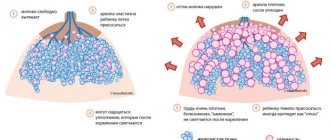Formation of lactation
As soon as the baby is born, it should be placed on the mother's breast. The first attachment can already be considered the beginning of lactation, but the main thing is ahead. The first nutrition that the baby receives is colostrum, which is then transformed into full-fledged breast milk.
Noticeable changes in the composition of milk will occur from the moment of the first application until mature lactation is established. To be fair, it is worth noting that qualitative changes in breast milk occur even after this event - the milk adapts to the baby’s needs.
During the first few days of breastfeeding, colostrum may continue to be released from the breast. Afterwards, it is replaced by early transitional milk, later by late transitional milk, and only then comes mature breast milk. On average, this transformation of breast milk occurs in 4-6 weeks.
Dynamics of the chemical composition of human milk during its maturation (per 100 ml)
| Nutrients of milk | Colostrum (1-5 days) | Transitional milk (6-14 days) | Mature milk (more than 15 days) | Content of nutrients in mature milk (% of content in colostrum) |
| Protein, g | 2,3 | 1,6 | 1,1 | 47 |
| Fat, g | 2,9 | 3,5 | 4,5 | 155 |
| Lactose, g | 5,7 | 6,4 | 6,8 | 119 |
| Energy value, kcal | 67 | 73 | 75 | 112 |
| Vitamin A, mg | 0,16 | 0,09 | 0,06 | 37 |
| Carotenoids, mg | 0,14 | 0,04 | 0,02 | 14 |
| Vitamin E, mg | 1,5 | 0,9 | 0,2 | 13 |
| Sodium, mg | 50 | 30 | 17 | 34 |
| Potassium, mg | 74 | 64 | 50 | 68 |
| Calcium, mg | 48 | 46 | 34 | 71 |
| Zinc, mg | 5,5 | 3,8 | 1,2 | 21,8 |
| Selenium, mcg | 42 | — | 15 | 35 |
When does mature lactation begin?
The process when full-fledged milk replaces colostrum and transitional milk is called mature lactation. On average, mature lactation is established at 2 months. But for many women, this process may occur earlier or slightly later - everything will depend on many factors.
Artificial regulation of the amount of milk can delay the process of the onset of mature lactation, when young mothers feel that the baby does not have enough of it. Worth o - one of the most common reasons for seeking help from consultants or a leading pediatrician. And it is precisely this fact that is associated with numerous errors.
To a lesser extent, but still, feeding on a schedule can delay the onset of mature lactation, for example, every 2.5-3 hours, and not when the baby requires it.
How to choose formula for artificial feeding. Complementary feeding table
Artificial feeding is used in cases where the mother's milk is completely absent or insufficient. When artificially feeding a child in the first months of life, one cannot suddenly or too quickly switch to a qualitatively new diet, since adaptation of the digestive system and metabolic processes occurs under great stress.
It is best to replace breast milk with adapted formulas (i.e., formulas that are as close in composition to human milk as possible). These formulas are intended for feeding a child from the first days of life until one year.
The use in recent years of a new generation of adapted milk formulas, which are as close as possible to the composition of human milk, has made it possible to significantly reduce the adverse effects of artificial feeding, in particular regarding the physical development and morbidity of infants.
When choosing the most appropriate formula for feeding a particular child, you should consider:
- Child's age. In the first 2-3 weeks of a child’s life, it is preferable to prescribe unleavened formulas, and then combine fresh and fermented milk formulas. The most appropriate is their equal ratio in the diet. An excess of fermented milk mixtures in the diet can cause (or intensify) regurgitation and disrupt the acid-base balance in the body.
- The degree of adaptation of the mixture. The younger the child is, the more he needs the most adapted mixtures. In no case should a child under 5-6 months be prescribed “follow-up formulas,” kefir and other unadapted fermented milk mixtures, or whole cow’s milk.
- Individual tolerance of the mixture.
One of the conditions that ensures the normal development of a child with artificial feeding is feeding according to appetite. At the same time, feeding hours are observed, and the amount of food at each feeding is given to the child as needed. Do not force the entire prescribed amount of formula or withhold a small additional amount.
Depending on appetite, the child may eat more than the norm at one feeding, and less at another, but he must receive the daily norm. The child's weight should be checked every month.
| Name of products and dishes | Age (months of life) | |||||||||
| 0-1 | 2 | 3 | 4 | 5 | 6 | 7 | 8 | 9 | 9-12 | |
| Adapted milk formula (ml) | 700-800 | 800-900 | 800-900 | 800-900 | 700 | 400 | 300-400 | 300-350 | 200 | 200 |
| Fruit juices (ml)* | according to indications | 5-30 | 40-50 | 50-60 | 60 | 70 | 80 | 90-100 | ||
| Fruit puree (ml)** | according to indications | 5-30 | 40-50 | 50-60 | 60 | 70 | 80 | 90-100 | ||
| Cottage cheese (g)* | 40 | 40 | 40 | 40 | 50 | |||||
| Yolk (pcs) | 0,25 | 0,5 | 0,5 | 0,5 | ||||||
| Vegetable puree (g)** | 10-150 | 150 | 150 | 170 | 180 | 200 | ||||
| Porridge (g) | 50-150 | 150 | 170 | 180 | 200 | |||||
| Meat puree (g) | 5-30 | 50 | 50 | 60-70 | ||||||
| Kefir and other fermented milk products or whole milk (ml)*** | 200 | 200 | 400 | 400 | ||||||
| Bread (g) | 5 | 5 | 10 | |||||||
| Rusks, cookies (g) | 3-5 | 5 | 5 | 10 | 10-15 | |||||
| Vegetable oil (sunflower, corn) | 3 | 3 | 3 | 5 | 5 | 6 | ||||
| Butter | 4 | 4 | 5 | 5 | 6 | |||||
*Depending on the child’s health condition and the degree of adaptation of the human milk substitute used in his diet.
** 2 weeks after the introduction of juice.
*** If necessary, earlier administration is possible (from 6 - 7 months)
Advertising
Signs of mature lactation
Many nursing mothers note that it is impossible to skip the process when mature lactation begins. New sensations appear, self-confidence appears, the process of feeding and communicating with the baby is brought to perfection.
Lactation consultants and pediatricians draw women's attention to signs of mature lactation, and if they appear, then everything is going in the right direction:
• change in sensations. Previously, many nursing mothers felt their breasts full, felt strong hot flashes, and relief occurred only after feeding the baby. Once mature lactation is established, such sensations may disappear or decrease significantly. Many women are concerned, because, in their opinion, either the milk has disappeared or it has become less, because. there are no more subjective sensations. In fact, this is not so, the breast has “learned” to work in the correct mode and produce “fresh milk” so that the baby is satisfied here and now, and also so that the reserves of milk in the breast are minimal;
• a stable flow of milk, while nursing mothers may not feel particularly strong tides;
• the breast becomes soft due to adaptation to work;
• there is no accumulation of reserves, that is, there is no unpleasant sensation of bloating or the possibility that the breast will “burst.”
When such signs of mature lactation form, many women begin to associate them with feeding problems and mistakes with breastfeeding, but this is not the case.
Mature lactation with autocrine regulation process
In the first stages of lactation development, the endocrine system - hormones - is responsible for the production of breast milk. This type of regulation is called endocrine. In this case, milk production occurs regardless of whether the baby is attached to the breast or not.
As lactation develops and improves, everything changes. Mature lactation with an autocrine regulation process suggests that the endocrine system no longer has its former influence, but the baby himself stimulates milk production during latching. This process triggers milk production: as soon as feeding is finished, milk production stops. Such regulation is one of the main signs of mature lactation.
Scheme for introducing complementary foods during breastfeeding
No matter how beneficial mother's milk is, the need gradually arises to expand the baby's diet. Growing by leaps and bounds, the body requires more and more energy, nutrients and microelements (protein, iron, zinc, etc.). In addition, the baby’s digestive system and chewing apparatus must gradually prepare for “adult” food.
Most researchers agree that complementary feeding should be introduced no earlier than 4-6 months. Although a baby can only feed on mother's milk up to 6 months.
| Name of products and dishes | Age (months of life) | Note | |||||||
| 0-3 | 4 | 5 | 6 | 7 | 8 | 9 | 9-12 | ||
| Fruit juices (ml) | 5-30 | 40-50 | 50-60 | 60 | 70 | 80 | 90-100 | from 3 months | |
| Fruit puree (ml) | 5-30 | 40-50 | 50-60 | 60 | 70 | 80 | 90-100 | from 3.5 months | |
| Cottage cheese (g) | 10-30 | 40 | 40 | 40 | 50 | from 5 months | |||
| Yolk (pcs) | 0,25 | 0,50 | 0,50 | 0,50 | from 6 months | ||||
| Vegetable puree (g) | 10-100 | 150 | 150 | 170 | 180 | 200 | from 4.5 - 5.5 months. | ||
| Milk porridge (g) | 50-100 | 150 | 150 | 180 | 200 | from 5.5 - 6.5 months. | |||
| Meat puree (g) | 5-30 | 50 | 60-70 | from 7 months | |||||
| Kefir and other fermented milk products or whole milk (ml) | 100 | 200 | 400-600 | from 7.5 - 8 months. | |||||
| Wheat bread, premium (g) | 5 | 5 | 10 | from 7 months | |||||
| Rusks, cookies | 3-5 | 5 | 5 | 10-15 | from 6 months | ||||
| Vegetable oil (sunflower, corn) | 1-3 | 3 | 3 | 5 | 5 | 6 | from 4.5 - 5 months. | ||
| Butter | 1-4 | 4 | 4 | 5 | 6 | from 5 months | |||
The food given to the baby as complementary foods should contain enough iron. Iron, which is contained in ordinary foods, is absorbed much worse than that contained in breast milk. Lack of iron can lead to the development of anemia.
Gradually, the range of “allowed” foods increases, and by the 8th month, complementary feeding can be done twice a day. The more solid food there is, the less the baby receives easily digestible substances contained in mother’s milk.
Expanding the diet requires a lot of attention and patience from the baby’s parents. After all, day after day the digestive system is being prepared so that the baby can eat “like an adult.” Some children already by the 9th month switch to independent, “adult” nutrition, others will complete their transition only at the beginning of the second year of their life.
Is it possible to speed up mature lactation?
Experienced nursing mothers and lactation consultants note that there is no one universal remedy that will help make lactation mature in a short period of time - this process depends on many factors. But, meanwhile, there are some general recommendations that will help establish lactation and the flow of mature milk:
• emotional state: a nursing mother should protect herself from stress and strong emotions that can contribute to “milk burnout.” As you know, strong emotions and violation of breastfeeding rules are one of the reasons for the formation of lactation crises;
• daily regime. Breastfeeding mothers are advised to adhere to a daily routine, get enough sleep, and set aside time for walks and for themselves;
• diet. Despite the availability of information, many breastfeeding mothers still adhere to a strict diet and are ready to live on buckwheat and boiled beef for 1-1.5 years. This position is wrong and harmful for both the child and the mother. A nutritious diet will help provide the baby with all the necessary nutrients and full milk production;
• the baby will always get his way. Many women simply do not realize how perfect the mother’s body is and what tasks are its priorities. The problem of “not enough milk”, in the vast majority of cases, is far-fetched and unfounded. Only in rare cases does the problem of milk shortage occur, and it is associated with some serious problems.
By following these simple rules, of course, it is impossible to transform still immature lactation into mature, but such recommendations will help to avoid many problems and improve the feeding process.
Comparison of the composition of breast milk and adapted formula
| Nutritional factor | Content in breast milk | Contents in an adapted mixture | Comments |
| Fats | Enriched with Omega-3, an important component for the development of the growing brain, namely DHA and AA, as well as gamma-linolenic acid, lecithin and taurine. Automatically adapts to the baby's needs. As the baby gets older, his concentration decreases. Rich in cholesterol Almost completely digestible Contains lipase - an enzyme that breaks down fats | Contains no DHA at all Does not adapt to the needs of the baby Contains no cholesterol at all Not fully digestible Contains no lipase at all | Fat is the most important nutrient in breast milk. Lack of cholesterol and DHA, vital nutrients for growing brains and organs, may predispose a child to future heart problems and central nervous system diseases. Remaining, unabsorbed fat explains the baby's foul-smelling stool. Omega-3 is docosahexaenoic acid, which is essential for the development of the newborn's brain and retina; DHA - docosahexaenoic acid AA - arachidonic acid gamma-linolenic acid, which optimizes the development of the psyche and body of newborn children; lecithin, which determines the development of the child’s brain, the volume of his intelligence and memory; sulfur-containing amino acid taurine, which determines inhibitory processes in the child’s brain. |
| Squirrels | Gentle, easily digestible serum. Most easily digestible. The protein content is higher in the milk of mothers who gave birth to premature babies. Contains lactoferrin - an important component for better intestinal function. Contains lysozyme, an antimicrobial enzyme. Enriched with proteins necessary for the structure of the brain and internal organs. Enriched with proteins necessary for growth factor. Contains proteins that stimulate sleep. | It curdles heavily in the baby's stomach. Not completely absorbed by the body, more waste puts a strain on the kidneys. Does not contain lactoferrin at all. Does not contain lysozyme at all. Defective or low in some proteins necessary for brain structure. Defective in growth factors. Does not contain enough sleep-promoting proteins. | Infants do not have allergic reactions to human milk protein. Lactoferrin. This natural antibiotic, found in human milk, protects the newborn during the difficult transition from the mother's body to the outside world filled with pathogenic microbes. Then, throughout life, it, present in the blood and various secretions of the body, protects a person from the harmful effects of the environment. Lysozyme is an enzyme that interacts with certain types of sugars in the cell wall of bacteria and destroys the membranes of bacterial cells. |
| Carbohydrates | Enriched with lactose. Enriched with oligosaccharides essential for healthy intestinal function. | Some mixtures contain no lactose at all. Contain imperfect oligosaccharides. | Lactose is an important carbohydrate for brain development. Research shows that the level of lactose in a species' milk is directly related to that species' brain size. |
| Immune carriers | Enriched with antibodies, millions of which are transmitted through mother's milk. Enriched with immunoglobulins. | Contains no living white blood cells or » any other cells. Dead food has less immunological benefit. Contains very few immunoglobulins, which often have an altered genetic appearance. | When a mother is exposed to germs (simply sick), her body produces antibodies to those germs and passes these antibodies to her baby through her milk. |
| Vitamins and Minerals | Vitamins and minerals are best absorbed through breast milk, especially iron, zinc, and calcium. Iron - from 50 to 75 percent absorption. Contains higher amounts of selenium (antioxidant). | Not well absorbed. Iron - from 5 to 10 percent absorption. Contains less selenium (antioxidant) | Vitamins and minerals are best absorbed from breast milk precisely when the baby’s body has a direct need for them. Whatever vitamin or mineral the body needs at the moment will be better absorbed. |
| Enzymes and Hormones | Enriched with digestive enzymes such as lipase and amylase Enriched with many hormones: thyroid, prolactin, oxytocin, and more than fifteen others The amount of vitamins and minerals directly depends on the mother's nutrition | Processing kills digestive enzymes Processing kills hormones that are not originally human Always has the same composition | Digestive enzymes determine gut health. Hormones contribute to the overall biochemical balance that is optimal for the infant. By absorbing the aromas and tastes of foods consumed by the mother, breast milk prepares the baby's taste sensations for the family's food preferences. |
| Price | About $600 per year in additional food supplies for the mother | About $1,200 per year Up to $2,500 per year if hypoallergenic formula is needed Cost of bottles and other bottle-feeding equipment Lost income when baby is sick | — |
Based on materials from www.AskDrSears.com
How to express milk during mature lactation
Some mothers are forced to go to work, and the question may arise about whether to continue breastfeeding or stop. The absence of the mother for several hours a day is not an indication for termination, and the baby can be fed with expressed milk. But how to express milk during mature lactation, when the process of its secretion can only be stimulated by application?
Lactation consultants remind you that there are some tricks to help the pumping process:
• before you start pumping, you need to take a hot shower and drink hot tea with milk;
• then start massaging the breast: move with light stroking movements from its base to the nipple;
• it is recommended to attach the baby to the other breast, which will stimulate the process of milk production;
• as soon as a woman feels a surge of milk, it is necessary to begin the process of expressing milk;
• during the day, when the nursing mother is separated from the baby, it is necessary to drink as much water as possible, but at the same time take into account thirst.
Sometimes pumping can play a cruel joke and cause lactation disruption - there is a risk of its complete cessation. In order to prevent this, you must adhere to certain rules, but the main thing is that when expressing milk using a breast pump (manual or electric), even after the sensation of emptying your breasts, you must continue expressing.
When expressing milk, it is best to take advice from experienced lactation consultants. Sometimes even experienced mothers can give incorrect advice, which complicates the situation and can worsen lactation, sometimes even making it lost. Obvious problems with feeding only aggravate the situation and make you nervous, which can only worsen lactation.











